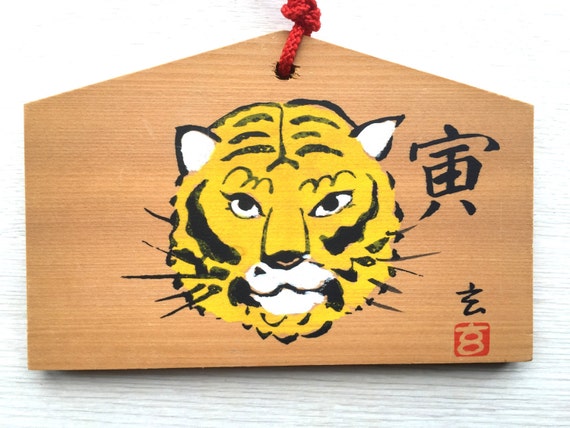
Japanese Temple Wood Plaque - Year of Tiger - Lucky Charm - Yasui Konpiragu - E7-10 - Ema Shrine Plaque
This is an "Ema". "Ema" are small wooden plaques on which Shinto worshippers write their prayers or wishes. The ema are then left hanging up at the shrine, where the kami (spirits or gods) receive them. They bear various pictures, often of animals or other Shinto imagery, and many have the word gan'i (願意), meaning "wish", written along the side. In ancient times people would donate horses to the shrines for good favor, over time this was transferred to a wooden plaque with a picture of a horse, and later still to the various wooden plaques sold today for the same purpose.
Ema are sold for various wishes. Common reasons for buying a plaque are for success in work or on exams, marital bliss, to have children, and health. Some shrines specialize in certain types of these plaques, and the larger shrines may offer more than one. Sales of ema help support the shrine financially.
******** This Ema is from Yasui Konpira Shrine , Japan.
The history of the shrine begins at the time of reign of the 38th Emperor Tenchi (668 to 671 C.E.), when Kamatari Fujiwara established the shrine, to pray for prosperity of the clan and eternal continuation of his descendants. planted purple wisteria and called it Fujidera (The Temple of Wisteria).
The 75th Emperor Sutoku ( reigned 1123-1141) who was especially fond of this wisteria, repaired the temple buildings in 1146 and had his favorite consort Awa no Naishi live there.
The retired emperor Sutoku was defeated during the Hogen Rebellion (1156) and passed away in the land of Sanuki (present day Kagawa Prefecture). His consort Awa no Naishi worshipped in the Kannon Hall of the temple the portrait, drawn in his own hand, that she had received from the emperor.
In 1177, when a Buddhist priest Daien stayed in the temple, the emperor Sutoku appeared before him, showing him a vision of the prosperity of ancient times. This event was immediately reported to the monk-emperor Goshirakawa and the Kanshōji, that was built by his imperial order, is said to be the origin of our shrine.
The temple Kōmyōin Kanshōji was devastated by fire spread by armies during the Ōnin Rebellion (1467-1477). However in 1695, the Rengekōin, originally located at Uzumasa Yasui (Ukyo Ward of Kyoto City) was moved to the present site. As shrine deities, alonside the emperor Sutoku, Ōmononushi no Kami (transferred from Konpira Shrine in the land of Sanuki) and prince Yorimasa Minamoto were enshrined here. The shrine then became known as “Yasui Konpiragu”.
After the Meiji Restoration (1868) the name Rengekōin was abandoned and the name of the shrine was changed first to “ Yasui Jinja” and later to “ Yasui Konpiragu” by which it is known today.
For more information and great pictures please see
http://www.greenshinto.com/wp/2013/10/15/yasui-konpira-festival/
http://thekyotoproject.org/english/yasui-shrine/
It measures 14.5cm x 9.5 cmx 8mm.

No comments:
Post a Comment